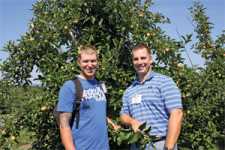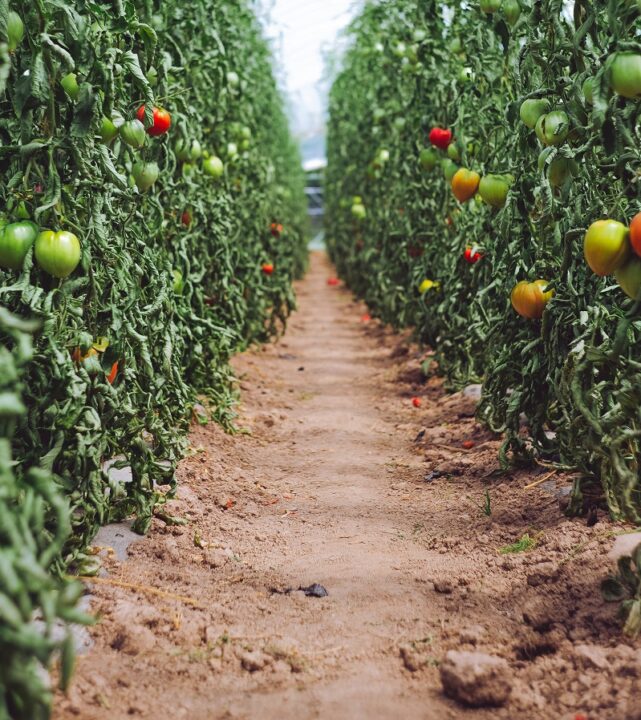Young Growers Tour Quebec With IFTA

Although only a few hours north of the U.S. border, Quebec is a different world. The French speaking Canadian Province is known for delicacies such as maple syrup, poutine, and, more importantly, apples. Thus, due to huge showings of Canadians at recent International Fruit Tree Association (IFTA) tours such as January’s trip to Santiago, Chile, our Northern neighbors were chosen to host 2012’s study tour, and host they did. In a carefully organized, whirlwind display of all things pomme, tour attendees were given a warm “bienvenue” at no less than 15 orchards, processing facilities, and cold storage centers, in two information-packed days.
Home to five apple producing regions generating $24.5 million in apple revenue, these growers knew what they were talking about. And, having brought along two Adams County, PA, natives from the Young Grower Alliance, Ben Lerew, 25 years old, of Lerew Brothers Orchards, and Tyler Fetters, also 25, of Fetters Orchards, American Fruit Grower magazine set out to soak it all in. What follows is a visual display of what Fetters and Lerew learned, and gained, during the tour (the first IFTA event for both of them).
Sprayer Technology
The first stop on the tour, The Research and Development Institute for the Agri-Environment (IRDA — Institut de recherché et de developpement en agroenvironnement), is an 19.7 acre orchard utilized for three purposes: research and development to create tools and protection measures that respect the environment and further the apple industry; a demonstration area used to show research in action; and a heritage area, considered an image of past production to preserve ancient and original cultivars of apple trees.
The IRDA showed visitors an innovative overhead, fixed spray treatment that would ideally save growers the time and effort of having to ride through the orchards to spray apples. The system, modeled after one from the Netherlands, is designed for ease of spraying on hills, where the mobile application of pesticides, thinners, and other products can be difficult due to maneuverability and safety.
Fetters viewed it as a good option for areas that would be difficult to get a conventional sprayer through, such as terrain that could not hold a good spray pattern with a pull sprayer, and believed that a little more work on the loading system is required. Lerew was in agreement, stating that although in the end it could save growers time, he was concerned about having to check all the lines that would run over hundreds of acres instead of simply checking the tubes of one machine. In addition, he was unsure about time saved the way it is currently set up, as a tank would have to be hauled and connected from place to place.
Although still in the trial period, the tests have proven interesting to growers, and Washington State University is developing its own fixed sprayer system complete with three tiers that could potentially cover more difficult-to-reach and vulnerable areas such as the undersides of leaves.
Pest Control
In addition to the spraying system, tour attendees were treated to a viewing of dwarf apple trees covered in nets for protection against insects, and, by default, the diseases vectored by them. Presented as a process that would involve a preliminary spray, and then the installation of the netting for a physical barrier between pests and the fruit itself, it was explained that this process is generally done for smaller, softer fruits like berries. The act of netting apple orchards is relatively uncommon in the U.S., and Lerew and Fetters explain why: “It could be a bit difficult to maintain for large scale growers” says Fetters, “having to roll the nets back and forth every time the tree needs to be worked with.” Lerew agreed. “It would probably take less time to simply apply the necessary protective applications via spray.”
The disease and pests that plague our Northern neighbors are not all too different from those found in the states, though, with one exception. The brown marmorated stink bug, a rapidly spreading issue for Eastern U.S. growers, has yet to make its way to Quebec. “I was surprised to hear they didn’t have stink bug pressure in Canada!” said Fetters, “especially considering it is an overwhelming issue in central Pennsylvania.” One common complaint, though, is fire blight. “The things we do here are just about the same as what they do there,” said Fetters, “but you could still see the harsh effects of it on some blocks.” Lerew shared some potentially time-saving knowledge he picked up along the tour, saying that a local specialist said that it was not necessary to sterilize the shears used to cut branches as long as they were cut far enough back from the infection site to avoid contamination. Understandably afraid of cutting back on protective measures, Lerew stated, “We’ll probably continue to sterilize anyway, just in case.”
Training Systems
As far as training systems go, a few Canadian methods differed from what Lerew and Fetters, and probably most American growers, are used to. One trial system shown was the use of plastic tensile wire. This practice, as explained by our hosts, has many benefits and, as with most things, a few drawbacks. One benefit, the ability to stretch and maneuver the wire with more ease than their metal counterparts, is beneficial should the wire snap for any reason, in which case it does not have to be fully replaced, simply stretched a bit and tied back together. The drawback, though, is ironically the fact that the plastic wire snaps quite a bit. “It didn’t seem to hold up well against the elements,” explained Fetters, “which would be a problem in Pennsylvania.”
In addition, Lerew commented on the seemingly widespread use of telephone poles for training systems in Canadian orchards. “They’re sturdy, that’s for sure!” In agreement, Fetters stated that they seem to be good anchors, but both Lerew and Fetters were wary of the aesthetic element. “It looked a bit industrial for what we’re going for,” said Lerew.
Equipment
Equipment was also a great source of interest on the tour, which displayed various pieces such as platforms and three-row sprayers. Lerew and Fetters both expressed interest in platforms, but doubt that they would be practical on the hilly land that dominates their region. “The Munckhof platform seemed to be a good idea that people have been working with for a long time,” said Fetters, “Of all the platforms I’ve seen and worked with, this one seemed the most practical.”
In addition, both Lerew and Fetters were impressed with the 3 row sprayers shown at the Fruiteraie Des Gadbois, an orchard with more than 30,000 dwarf apple trees and about 7.4 acres of highbush blueberries. The top-mounted, air-assist sprayer developed jointly by Univerco Agriculture, Agri-Food Canada, and Fruiteraie, interested Fetters, who said, “It seems like a great way to get things done in such as scale as was seen at Fruiteraie. It might take some time to get used to running it, but when you can cut your time in more than half, as the owner said, I guess it pays for itself.”
Marketing
Canada also displayed many value-added products that not only help their bottom line, but emphasize the importance of culture for the area. A tour of the Cidrerie Du Minot in Hemmingford, Quebec, a 128.4 acre orchard and cider mill run by the Demoy family, showed how produce can be processed on site for profit. In addition to bottling 200,000 bottles per year of Canada’s famed hard cider, the family explained how they overcame the area’s frosty nights with the help of a ground-mounted frost control wind machine that works by pulling in and pushing up the cold air. The machine, which uses minimum amounts of fuel and moves approximately 100,000 cubic feet of air per minute, made a considerable difference in the condition of the trees and fruit within seven acres of its location. The operation also uses the cold weather to its advantage to make iced hard cider, a practice where the fruit is picked after three nights at -15˚F.
Direct marketing practices like these interested both of the Adams County natives. Lerew, whose family currently doesn’t utilize any of the methods he saw in Canada, stated that the various uses for the operation other than for sole production of fruit interested him. “Although I don’t think we need a farm market, because the operations on either side of us have one, we could find ourselves in a situation where we’re buying produce from them just to keep our shelves stocked. Many of the things they were doing were very creative.”
Speaking in reference to Verger Bel Horizon and Ferme C.M.J.I Robert, in the famous Rougemont area of Quebec, which had a summer camp on location complete with a ropes course and lunchboxes depicting the lay of the land, it was demonstrated that there are endless possibilities of what can be done as far as agritainment goes. Fetters agreed, saying, “Each place we visited had its own way. The restaurants on site with a market attached and crafts, with the wines and ciders right there, is a great idea.”
The socializing opportunities for growers who attend IFTA are an undeniable benefit. “The Canadian growers all used the same chemicals, application rates, and almost the same timing as we do in the states, with maybe a week or 10 days difference,” said Fetters, “but the opportunity to meet people and see what they are up to as far as varieties, and even buying opportunities, is reason enough to go.” Lerew agreed, stating that although his dad and uncle make most of the decisions, he’ll be coming up in the industry soon enough, and getting started sooner rather than later for networking opportunities is important.









